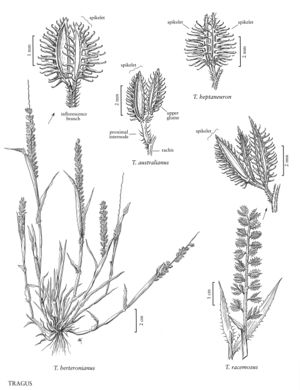Tragus australianus
Plants annual. Culms 10-45 cm. Ligules 0.5-1 mm; blades (0.7)3.5-7 cm long, (1.5)2-4 mm wide, surfaces glabrous. Panicles (4.5)6-13.5 cm long, 7-9 mm wide; rachises pubescent; branches 0.7-1.2 mm, pubescent, with 2(3) spikelets, axes rarely extending past the distal spikelets; proximal internodes 0.6-1 mm, usually 2-3 (or more) times longer than the second internodes. Proximal spikelets 3.1-3.5 mm; second spikelets 2.7-3.3 mm. Lower glumes absent or to 0.4 mm, glabrous; upper glumes 3.1-3.5 mm, minutely pubescent, 5-veined; glume projections 7-10, in 5 rows, 0.2-0.8 mm, uncinate; lemmas 2.4-2.6 mm, sparsely pubescent on the back, midveins sometimes excurrent to 0.2 mm; paleas 2-2.2 mm; anthers 3, 0.4-0.5 mm, yellow. Caryopses 1.2-1.5 mm long, 0.6 mm wide. 2n = unknown.
Distribution
S.C.
Discussion
Tragus australianus is native to Australia, where it becomes established rapidly on disturbed or bare soil after summer rains. In the Western Hemisphere, it is known from Berkeley and Florence counties, South Carolina, and Argentina.
Selected References
None.
